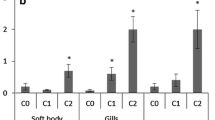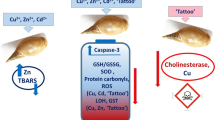Abstract
Polychaete worms (Hediste diversicolor) originating from a strongly metal-contaminated area (Restronguet Creek) and a relatively clean site (Blackwater estuary) were exposed to a range of experimental doses of Ag, Cd, Cu and Zn. Specimens from both populations were compared to assess their relative sensitivity to metal stress and the physiological mechanisms involved in their respective adaptive strategies for coping with increased metal exposures. Taking into account the LC50 values, increased tolerance to Cd, Cu and Zn of the Restronguet Creek worms over that of the Blackwater was demonstrated, whereas the opposite was shown for Ag. An abundant secretion of mucus in response to toxicants was observed, possibly reducing metal availability for uptake, at least under laboratory conditions. This mechanism was particularly active in specimens from Restronguet Creek exposed to Ag and Cu. Unexpectedly, of the two worm populations, Blackwater worms contained significantly higher concentrations of cytosolic heat-stable compounds (CHSTC), a category of cytosolic components that includes metallothioneins, the detoxificatory role of which is well documented, and other compounds binding trace metals via sulphur bonds. However, the concentration of such compounds is not totally representative in itself of their involvement in metal detoxification, because a high rate of their turnover in metal-exposed worms might be responsible for (at least) the Cu storage associated with S in lysosomes as a consequence of the breakdown of Cu-thionein. Cu-containing lysosomes were abundant in epidermal cells of Restronguet Creek worms, but were lacking in Blackwater worms. Extracellular granules present in the epicuticle also contained S and Cu, their number and size being much more important in Restronguet Creek worms, and they appear to be a major detoxificatory store for accumulated Cu. Spherocrystals in cells of the gut wall seem to be the major detoxified store of Zn in Restronguet Creek worms, whereas in specimens from the Blackwater they were also present but contained only S and Ca at detectable levels. Evidence was also found for the presence of detoxificatory intracellular structures containing other metals and metalloids in the tegument and gut epithelium of Restronguet Creek worms.








Similar content being viewed by others
References
Amiard JC, Pineau A, Boiteau HL, Métayer C, Amiard-Triquet C (1987) Application of atomic absorption spectrophotometry using Zeeman effect to the determination of eight trace elements (Ag, Cd, Cr, Cu, Mn, Ni, PB and Se) in biological materials. Water Res 21:693–697
Berthet B, Mouneyrac C, Amiard JC, Amiard-Triquet C, Berthelot Y, Rainbow PS, Smith BD (2003) Response to metals of the polychaete annelid Hediste diversicolor, a key species in estuarine and coastal sediments. Arch Environ Contam Toxicol (in press)
Bliss CI (1938) The determination of the dosage–mortality curve from small numbers. Q J Pharmacol 2:192–216
Boilly B, Richards A (1978) Accumulation de fer chez une annélide polychète: Magelona papillicornis (M). CR Acad Sci Paris 286:1005–1008
Bradford M (1976) A rapid and sensitive method for quantification of microgram quantities of protein utilizing the principle of protein dye binding. Anal Biochem 72:248–254
Brdicka A (1933) Polarographic studies with the dropping mercury method. A new test for proteins in the presence of cobalt salts in ammoniacal solution of ammonium chloride. Collect Czech Chem Commun 5:112–128
Brown BE (1982) The form and function of metal-containing "granules" in invertebrate tissues. Biol Rev 57:621–667
Bryan GW (1974) Adaptation of an estuarine polychaete to sediments containing high concentrations of heavy metals. In: Vernberg FJ, Vernberg WB (eds) Pollution and physiology of marine organisms. Academic, New York, pp 123–135
Bryan GW (1976) Some aspects of heavy metal tolerance in aquatic organisms. In: Lockwood APM (ed) Effects of pollutants on aquatic organisms. Cambridge University Press, Cambridge, pp 7–34
Bryan GW, Gibbs PE (1983) Heavy metals in the Fal Estuary, Cornwall: a study of long-term contamination by mining waste and its effects on estuarine organisms. Occas Publ Mar Biol Assoc UK 2:1–112
Bryan GW, Hummerstone LG (1971) Adaptation of the polychaete Nereis diversicolor to estuarine sediments containing high concentrations of heavy metals. I. General observations and adaptation to copper. J Mar Biol Assoc UK 51:845–863
Bryan GW, Hummerstone LG (1973) Adaptation of the polychaete Nereis diversicolor to estuarine sediments containing high concentrations of zinc and cadmium. J Mar Biol Assoc UK 53:839–857
Bryan GW, Langston WJ, Hummerstone, Burt GR (1985) A guide to the assessment of heavy metal contamination in estuaries using biological indicators. Occas Publ Mar Biol Assoc UK 4:1–9
Bryan GW, Gibbs PE, Hummerstone LG, Burt GR (1987) Copper, zinc, and organotin as long-term factors governing the distribution of organisms in the Fal Estuary in Southwest England. Estuaries 10:208–219
Campbell MJ, Radecki Z, Trinkl A, Burns KI (2000) Report on the intercomparison runs for the determination of trace and minor elements in cabbage material. Rep. IAEA/AL/123, IAEA-359, Vienna
Coquery M, Horvat M (1996) The analytical performance study for the MED POL area: determination of trace-elements in marine sediment SD-MEDPOL-1/TM and fish homogenate MA-MEDPOL-1/TM. Report, IAEA, Monaco
Couillard Y, Campbell PGC, Tessier A, Pellerin-Massicotte J, Auclair JC (1995) Field transplantation of a freshwater bivalve, Pyganodon grandis, across a metal contamination gradient. I. Temporal changes in metallothionein and metal (Cd, Cu and Zn) concentrations in soft tissues. Can J Fish Aquat Sci 52:690–702
Dennaï N, Dhainaut-Courtois N, Bouquegneau JM, Nejmeddine A (1986) Effets du cadmium et du mercure sur un ver marin (Nereis diversicolor O.F. Müller). Mécanismes de détoxication. CR Acad Sci Paris 302:489–494
Dines HG (1969) The metalliferous mining region of south-west England. Her Majesty's Stationery Office, London
Farmanfarmaian A (1985) Fractional distribution of 203HgCl2 and CH3 203HgCl in the intestine of a marine fish. Mar Environ Res 17:176–180
Fernandez TV, Jones NV (1989) The distribution of zinc in the body of Nereis diversicolor. Trop Ecol 30:285–293
Gabe M (1968) Techniques histologiques. Masson and Cie, Paris
George SG (1982) Subcellular accumulation and detoxication of metals in aquatic animals. In: Vernberg WB, Calabrese A, Thurberg F, Vernberg FJ (eds) Physiological mechanisms of marine pollutants' toxicity. Academic, New York, pp 3–55
Gibbs PE, Burt GR, Pascoe PL, Llewellyn CA, Ryan KP (2000) Zinc, copper and chlorophyll-derivatives in the polychaete Owenia fusiformis. J Mar Biol Assoc UK 80:235–248
Grant A, Hateley JG, Jones NV (1989) Mapping the ecological impact of heavy metals in the estuarine polychaete Nereis diversicolor using inherited metal tolerance. Mar Pollut Bull 20:235–238
Hateley JG, Grant A, Jones NV (1989) Heavy metal tolerance in estuarine populations of Nereis diversicolor. In: Ryland JS, Tyler PA (eds) Reproduction, genetics and distribution of marine organisms. Proc 23rd Eur Mar Biol Symp. Olsen and Olsen, Fredensborg, pp 379–385
Hummel H, Paternello T (1994) Genetic effects of pollutants on marine and estuarine invertebrates. In: Beaumont AR (ed) Genetics and evolution of aquatic organisms. Chapman and Hall, London, pp 425–434
Hummel H, Amiard-Triquet C, Bachelet G, Desprez M, Marchand J, Sylvand B, Amiard JC, Rybarczyk H, Bogaards RH, Sinke J, de Wit Y, de Wolf L (1996) Sensitivity to stress of the estuarine bivalve Macoma balthica from areas between the Netherlands and its southern limits (Gironde). J Sea Res 35:315–321
Ireland MP, Richards KS (1977) The occurrence and localisation of heavy metals and glycogen in the earthworm Lumbricus terrestris and Dendrobaena rubida from a heavy metal site. Histochemistry 51:153–166
Klerks PL, Weis JS (1987) Genetic adaptation to heavy metals in aquatic organisms: a review. Environ Pollut 45:173–205
Koechlin N, Grasset M (1988) Silver contamination in the marine polychaete annelid Sabella pavonina. a cytological and analytical study. Mar Environ Res 26:249–263
Langston WJ (1980) Arsenic in UK estuarine sediments and its availability to benthic organisms. J Mar Biol Assoc UK 60:869–881
Langston WJ, Bebianno MJ, Burt GR (1998) Metal handling strategies in molluscs. In: Langston WJ, Bebianno MJ (eds) Metal metabolism in aquatic environment. Chapman and Hall, London, pp 219–283
Luoma SN (1977) Detection of trace contaminant effects in aquatic ecosystems. J Fish Res Board Can 34:436–443
Marigomez I, Soto M, Cajaraville MP (1995) Morphofunctional patterns of cell and tissue systems involved in metal handling and metabolism. In: Cajaraville MP (ed) Cell biology in environmental toxicology. University of the Basque Country Press, Bilbao, Spain, pp 89–134
Mason AZ, Jenkins KD (1995) Metal detoxification in aquatic organisms. In: Tessier A, Turner DR (eds) Metal speciation and bioavailability in aquatic systems. Wiley, Chichester, pp 479–608
Morgan JE, Morgan AJ (1989) Zinc sequestration by earthworms (Annelida, Oligochaeta) chloragocytes. An in vivo investigation using fully quantitative electron probe X-ray micro-analysis. Histochemistry 90:405–411
Mouneyrac C, Amiard JC, Amiard-Triquet C, Cottier A, Rainbow PS, Smith BD (2002) Partitioning of accumulated trace metals in the talitrid amphipod crustacean Orchestia gammarellus: a cautionary tale on the use of metallothionein-like proteins as biomarkers. Aquat Toxicol 57:225–242
Nassiri Y, Rainbow PS, Amiard-Triquet C, Rainglet F, Smith BD (2000) Trace metal detoxification in the ventral caeca of Orchestia gammarellus (Crustacea: Amphipoda). Mar Biol 136:477–484
Noël-Lambot F (1981) Presence in the intestinal lumen of marine fish of corpuscles with a high cadmium-, zinc- and copper-binding capacity: a possible mechanism of heavy metal tolerance. Mar Ecol Prog Ser 4:175–181
Pirie B, Fayi L, George SG (1985) Ultrastructural localisation of copper and zinc in the polychaete Nereis diversicolor, from a highly contamined estuary. Mar Environ Res 17:197–198
Prento P (1979) Metals and phosphate in the chloragosomes of Lumbricus terrestris and their possible physiological significance. Cell Tissue Res 196:123–134
Rainbow PS (1995) Physiology, physicochemistry and metal uptake—a crustacean perspective. Mar Pollut Bull 31:55–59
Rainbow PS (1997) Ecophysiology of trace metal uptake in crustaceans. Estuar Coast Shelf Sci 44:169–175
Rainbow PS, Amiard-Triquet C, Amiard JC, Smith BD, Best SL, Nassiri Y, Langston W (1999) Trace metal uptake rates in crustaceans (amphipods and crabs) from coastal sites in NW Europe differentially enriched with trace metals. Mar Ecol Prog Ser 183:189–203
Thompson JAJ, Cosson RP (1984) An improved electrochemical method for the quantification of metallothionein in marine organisms. Mar Environ Res 11:137–152
Thompson M, Wood R (1993) The international harmonized protocol for the proficiency testing of chemical analytical laboratories. IUPAC/ISO/AOAC. J Pure Appl Chem 65:2123–2144
Viarengo A, Nott JA (1993) Mechanisms of heavy metal cation homeostasis in marine invertebrates. Comp Biochem Physiol C 104:355–372
Vovelle J, Grasset M (1991) Experimental silver bioaccumulation in the polychaete Pomatoceros triqueter. Biometals 4:107–112
Wallace WG, Lopez GR, Levinton JS (1998) Cadmium resistance in an oligochaete and its effects on cadmium trophic transfer to an omnivorous shrimp. Mar Ecol Prog Ser 172:225–237
Acknowledgements
The authors thank A. Anglo and L. Massot for their technical help in preparing the samples for EPMA and electron microscopy. Studies were carried out at the Centre de microscopie électronique de l'IFR de Biologie Intégrative and the Service inter-universitaire Assistance à la Recherche, Université Pierre et Marie Curie, Paris, France. This work was carried out in the framework of a PICS (International Programme of Scientific Co-operation) project funded by the CNRS (French National Scientific Research Centre). All the experiments presented in this paper complied with the current laws of the United Kingdom, where they were performed.
Author information
Authors and Affiliations
Corresponding author
Additional information
Communicated by S.A. Poulet, Roscoff
Rights and permissions
About this article
Cite this article
Mouneyrac, C., Mastain, O., Amiard, J.C. et al. Trace-metal detoxification and tolerance of the estuarine worm Hediste diversicolor chronically exposed in their environment. Marine Biology 143, 731–744 (2003). https://doi.org/10.1007/s00227-003-1124-6
Received:
Accepted:
Published:
Issue Date:
DOI: https://doi.org/10.1007/s00227-003-1124-6




